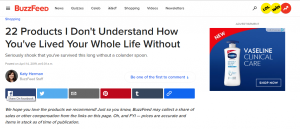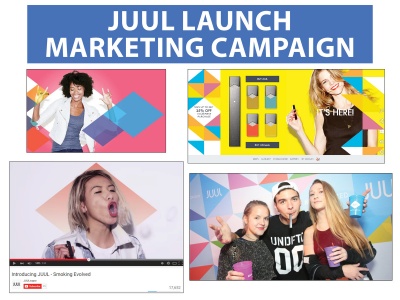Advertising ethics online
Advertising Ethics Online is a relatively new concept where technological growth has created a new space for advertisement in online markets and social media. As businesses expand their marketing online, they create new ethical challenges in advertising. Many of the top companies today, such as Facebook, Snapchat and Google, have grown substantially and can turn a greater profit without user expense, largely due to their strategies with selling advertisements online.[1][2]
Contents
Ethical Advertisements
Advertising is the method by which a seller communicates and promotes their product to a potential consumer. Ethics involves systematizing, defending, and recommending concepts of right and wrong behavior.[3] Ethics in regards to advertising governs the communication between buyers and sellers using well-defined principles that differentiate morally right and wrong conduct. [4] An ad that is ethical does not make false claims, or outright lie about the product for sale. An ethical ad showcases the product in a fair and truthful manner so as to not fool the consumer into believing false ideas about its abilities or effects. However, many advertisements often involve some type of exaggeration of a product or its benefits in an effort to increase demand and, therefore, sales. These exaggerations are often false and lead consumers to buy products without much thought. [3] In order to combat this problem, there are five main solutions suggested. First, companies can write self-regulatory rules ensuring that their ads communicate the truth. Second, companies can keep track of advertisements and remove those that violate ethical principles. Third, advertisers can educate the consumers about the ethical regulations implemented in the company. Fourth, advertisers should take note of consumer complaints in regards to advertisements. Finally, companies should be transparent in their transactions, which applies to both the company and the consumer.
Technological developments in advertising
Technological developments within the last decade have allowed large corporations to access the private data of users, including location, search history, and web browser cookies, among others. This information can be used to tailor advertisements to people based on their individual preferences through advancements in machine learning Algorithms and various other techniques. This has led to heightened concerns in regards to user privacy, data protection, reach, and corporate transparency in advertising.
Targeted advertisements
Over the last decade, advancements in technology have led to more widespread use of targeted advertising. Targeted advertising is advertising carried out to specific demographics such as age, gender, location, purchase, and search history. More detailed personal information has generated concern. If privacy is “freedom from informational interference or intrusion, achieved thanks to a restriction on facts about her that are unknown or unknowable,”[5] then online data collection for commercial purposes violates users' privacy. There is little to no information friction present that prevents targeted advertisements from retrieving information about people and their preferences. Targeted advertisements shed light on the lack of privacy in online interactions and address the whether or not having tailored advertising and information is in the best interest of the consumer.
Targeted advertisements leads to concern for both the general population and pre-adulthood vulnerability, as they are even more distressing when presented to younger consumers. A study conducted by Masaryk University surveyed 14-to-16-year-olds’ perceived privacy control and the effects of targeted advertisements. It was proven that even while “privacy control salience” enabled more probable recognition of targeted advertisements by subjects, the subjects were more likely to be persuaded by the targeted advertisements.[6]
One solution for the privacy concerns of target advertising is to offer compensation for retrieving personal information. A proposal published in the Computer Networks journal suggests utilizing ad brokers who offer monetary compensation for personal information from consumers piece by piece and are paid for their services by advertisers. [7] Such an exchange fulfills the Nash Equilibrium game theory, in which all players receive the best outcome, and has already come to life via data-payment cafes.[8]
Targeted advertising, although invasive of private user data, can in fact help consumers find what they are looking for faster. Despite the unethical privacy breach of utilizing location and previous behavioral data to manipulate products that pop up first, this can also be viewed as beneficial for the consumers. By prioritizing items that the algorithm deems valuable to the user, the personalized search results in fact may increase efficiency of online shopping by narrowing down the options to those most favorable to that individual based on statistics. By extracting data on purchasing preferences, a user can also be provided with personalized deals and the delivery of recurring purchases can be automated for consumer ease. The unethical privacy invasion and control of user choices based on the extraction of user data can in turn increase convenience at the same time.
Social Media
Most social media companies generate revenue by selling information from users to advertisers. Prominent social media companies, such as Facebook and Twitter, are attractive to advertisers because these websites have millions of users and store a significant amount of user data [9]. Social media companies are a significant driver of targeted advertising. Facebook in particular collects data from every like, post, and location update to gain insight on a user’s interests and background. Facebook puts users into categories based on age, suspected income level, interests, cellphone type and more [10]. Advertisers buy this information from Facebook to generate advertisements that are specific to certain audiences in order to successfully market their products [10]. Advertisers use analytical tactics to combine data points from users to make extremely precise targeted advertisements [10]. It is unclear exactly how Facebook creates its user categories for advertisers and how much information about a user’s activity is monitored. Yet, Facebook is still able to create a user profile based solely upon public user data.
Retargeting
Also known as re-marketing, this form of targeted online advertising utilizes cookies and basic javascript snippets to follow and track users' online behavioral patterns. The main objective surrounding this form of online advertising is placing advertisements on the screens of customers who have already visited your website, once they have clicked away but have not yet converted. This form of targeted advertising is especially useful to companies who gain a lot of traffic but may not see a great user conversion rate. This method of retargeting will "remind" the user of the product they were previously looking at when they are scrolling through their Facebook feed or watching a Youtube video, for example, in hopes to increase the likelihood of a purchase in the future.
Native Advertisements
In addition to ads becoming more targeted, they have also become harder to distinguish. Native Advertising "is a term used to describe any paid advertising that takes the specific form and appearance of editorial content from the publisher itself."[11] While native advertising is beneficial to advertisers because they are able to charge more for native advertising content than for overt display ads, which users are more likely to ignore or avoid, they are also potentially insidious as consumers might not recognize such content as advertising at all.[11] For news sites, native advertising presents a double-edged sword, as they are only effective if they appear "native," yet making them too native-looking violates journalistic principles of fairness and impartiality. Thus, news sites tend to clearly mark their native advertisements.
The use of native advertising becomes less principled on sites such as BuzzFeed. As a "free, open platform for launching buzz," BuzzFeed is essentially a clout-machine, directing consumer's attention towards the latest trends, while advertising clients pay to craft, direct attention towards, or ride these trends.[12] As a result of this business model, Buzzfeed does attempt to delineate advertised content from regular content nearly as much as the New York Times. While advertisements on behalf of advertisement firms are (somewhat) disclosed, advertisements on behalf of celebrities such as the Kardashians and Chrissy Teigen are more nebulous. Given the site's unusual attention to any event in the Kardashian's lives, many consumers have speculated that there is a business relationship between them. However, this remains unconfirmed.
Influencer Advertisements / Sponsored Posts
Sponsored posts are a unique form of native advertising present on social media networks such as Facebook, YouTube and Instagram. In a sponsored post, a sponsoring company pays an influencer an undisclosed amount of money to post a picture or a review of the company's product.[13] Because influencers craft Parasocial Relationships with their audiences, they are viewed as "authentic" sources of information, increasing the effectiveness of sponsored posts.
However, influencers themselves are often unaware of advertisement disclosure laws, and therefore mislead their audiences into thinking that their product recommendations are honest. In 2017, controversies revolving around Fyre Festival shed new light on how influencer advertisements can lead to fraud. The organizers of Fyre Festival including Billy McFarland promised the festival to be a memorable event accompanied by luxurious housing, gourmet meals, and performances by celebrities. However, the actual event shared minimal resemblance to the one that was promised. It was revealed in the aftermath that social media influencers who endorsed Fyre Festival during its marketing campaigns such as Kendal Jenner, was paid $250,000 for promoting the festival through her Instagram.[14] Other significant influencers also received monetary incentives or other rewards for their endorsement of the event. Despite not receiving legal charges, several social media influencers including Bella Hadid did issue apologies to her followers for misleading them.[14] Discussions around the Fyre Festival fraud indicate a need for more established policies and ethics toward influencer advertisements.
Another example of influencer endorsement controversy is with the Kardashian sisters posting about various diet-related products. One such product being appetite suppressants which Kim Kardiashian posted about (and then deleted) on Instagram and Twitter. Debate broke out about the promotion of a product seen as unhealthy to young and impressionable fans. In addition, this could advocate unhealthy body image and habits to an already vulnerable audience. Kim has previously received repercussions from advertisements on social media, including an ad for a morning sickness pill that received attention from the FDA for not listing the side effects[15]. This suggests that influencers do not necessarily feel responsibility for the sometimes serious outcomes of promoting products to their fans and followers.
Many influencers believe that if they are based in a different country, or if they do not outright endorse a product, they don't have to disclose their sponsorship. Others have opted to use "#sp" to display their sponsorship. Influencers following these shoddy disclosure practices have been warned by the Federal Trade Commission to be more upfront about their endorsements and partnerships. Furthermore, the Instagram platform has recently made changes that force sponsored posts to be more visible for consumers.
Ethical Issues
Bias in Ads
Bias in advertising has been evident since the 1920's. African Americans were one of the main minorities attacked by such implemented biases. Blacks were represented in stereotypical and racists ways across advertisements.[16] Skin lighteners, hair products, and even syrup poorly represented African Americans, making them seem subservient, ignorant, and ugly.[16] This was not by coincidence since advertising agencies were predominantly white up until the 1960's. Whites created ads that benefited themselves which led to the either purposeful or ignorant implementation of their biases, including racism.
Other groups such as old people, women, disabled, the poor, and the LGBTQ+ community are also victims of advertisement bias. One potential solution to depleting unconscious bias in ads is research. [17] Research of targeted clients and the culture of the surrounding area where marketing is to be done can effectively reduce bias. Progressive ads, which address the victims of ad bias in appropriate ways, are becoming more frequent and tend to trigger more positive engagement in the long run.[17] As commercial advertisement grows bias will inevitably occur until it is properly addressed.
In 2018, Pinterest rolled out a feature that allows users to select their skin tone so that results can be better catered towards them. Pinterest engineer, Laksh Bhasin, wrote on Pinterest's blog, that in order to prevent further bias across the Internet, like targeted ads, Pinterest prioritized user's privacy with this feature. A user needs to select the skin tone for every new search. The search feature "forgets" this information as not to collect any personal details related to ethnicity, which could consequently contribute to targeted ads.[18].
Bias in Google Advertisements
Bias on Google, specifically with their advertisements, is very prevalent. For example, Google’s algorithm shows more prestigious and executive level jobs to men. This bias begins with the algorithms and when human biases are written into the code. When a user types “CEO” into the Google search bar, only white males show up in the images. Furthermore, due to the way that user’s digital footprints are tracked, when a user searches for job postings online, Google can try to figure out if the user is male or female and from there gives them different job advertisements. In 2015, Carnegie Mellon University published a study that showed Google’s online ad platform was 141% more likely to show an ad for high-earning jobs to men rather than women [19]. The sponsors of the advertisements may specify that their advertisement only be shown to a certain gender or demographic, and this leads to bias as well. Algorithms work to be extremely personalized, therefore users behaviors online are tracked and the advertising algorithm learns from these searchers furthering the biases in the algorithm[20]. "
Underage vulnerability to advertising
Targeting children with lucrative advertisements is one of the greatest concerns, as children lack the ability to determine if the advertised products are actually in their best interests. [21] A study conducted by the World Advertising Research Center found that when advertisements use implicit persuasion, such as the use of celebrities or subliminal messages and associations, children are more easily persuaded. Furthermore, cognitive psychology research concluded that after adolescence and even into the phase of "early adulthood”, that the brain’s prefrontal regions, which control the response to subliminal stimuli, are fully developed and can recognize and resist against subliminal stimuli.[22] Therefore, children can't process the information they are given in a fair or just way.
A study conducted by the Federal Trade Commission in 1997 found that 86 percent of the sites listed on a popular children’s website directory collected “personally identifiable information” from children. [23]. In response to constantly rising concerns regarding children’s engagements with advertising, the FTC instituted the Children’s Online Privacy Protection Act (COPPA) in 2000. COPPA requires online advertisers to gain parental consent when advertising to anyone under the age of thirteen. However, targeting children in advertising is still largely unregulated as “only twenty-three percent of ad sites that collect personal information of children under thirteen comply with COPPA.”[24][25]
Transparency
Issues such as underage vulnerability and privacy invasion via targeted advertisements led to more awareness in terms of corporate transparency due to their online advertising. Researchers at Columbia Business School discovered that 80% of the participants in a study were willing to share their shopping and browsing data for customized ad experiences. However, 86% of the participants want to have more control of their data by having the option of opting out of customized ad experiences.[26] It is true that customers have the right to share or not share data collection prior to companies collecting user's data. Companies have the responsibility to inform customers and allow them to choose whether or not to agree to the advertisement tracking methods used by the companies prior to presenting customized ads.
Unfortunately, there hasn't been much progress in regards to legal action to change the corporate transparency methods. In 2011, the American Advertising Federation’s Institute for Advertising Ethics published an outline Principles and Practices for Advertising Ethics to set a baseline on moral objectives in advertising. The central theme lay in transparency, particularly establishing consumer relationships “in a fair, honest, and forthright manner.”[27] Unfortunately, these outlines are not enforced. Because of this, companies are free to create their own privacy and ethical policies, but recent events have led to public scrutiny of such policies. When nothing is done to allow people to opt out of having their data used, individuals lose their autonomy.
Unauthorized Purchases
One major ethical issue surrounding personalized ads has come from in-app purchases made by children without parental consent. Numerous mobile and web applications offer various premium upgrades which allows kids to make purchases through their parents' bank accounts without their agreement. This has led to numerous cases of children spending exuberant amounts of money within popular apps, resulting in legal action between parents and the companies who issue these apps.
In January of 2014, Apple Inc. agreed to a settlement with the Federal Trade Commission that required Apple to reimburse $32.5 million dollars in app store and in-app purchases to parents since children made purchases without the parents' consent.[28] The settlement also required that Apple instill further security measures for in-app purchases, including getting explicit parental consent for any purchase in order to ensure informed consent prior to charging customers.
While enforcement of the Federal Trade Commission's ruling led Apple Inc. to take measures such as fingerprint identification and password requirement for all billing purposes, the issue of unauthorized purchases hasn't disappeared. The Federal Trade Commission mandated that Apple establish these changes by March 31, 2014, but a notorious since-deleted twitter rant by rap artist Kanye West made it clear that in-app purchases were still a problem.[29]
Unwanted Exposure
Exposure of the Common Man
Generating user-targeted advertisements carries the risk of the person behind the screen not being the intended user, leading to serious privacy concerns. Many sites can track user activity by IP address which allow them to track multiple people on a single device to retrieve a variety of ads. Additionally, the tech industry's trend towards an oligopoly has caused similar problems. When a user asks Google Home a question, this information is associated with their Google account and can lead to targeted ads on any device upon their Google account. Likewise, Facebook's purchase of Instagram has provided them access to two of the four most popular social media platforms in the world, and information from either account can cross over. This poses a threat of misinformation when using targeted ads as it can have extensive consequences.
The most notorious case occurred in 2011 when a family wasn't aware of their teen daughter's pregnancy until they received a Target mail coupon catalog full of baby items. The Forbes report on the incident shares that Target collects their purchase history information and combines it with demographic information which they buy from 3rd parties to create profiles to target each customer."[30] This incident illustrates the breach of privacy and unwanted exposure for consumers when companies use targeted advertisements.
Ad Safety, A Different Ethical Concern
In certain instances, the advertising industry experiences unwanted exposure. Although most people experience targeted ads, lots of advertisements are misplaced. An ethical concern, Ad fraud is a multi-billion dollar crime industry. Irresponsibly placed by publishers, advertisements can end up on websites where no user ever travels (just bots), or on sites that do not align with a brand/advertiser's products or values. The World Federation of Advertisers (WFA), an association with members belonging to the top 500 advertisers in the world[31], published a Global Media Charter in 2018 outlining the conditions for the ideal marketing ecosystem for both consumers and brands. This Charter places “Zero tolerance to ad fraud with compensation for any breach” as its first principle. And previously, in 2016, the WFA published the first Ad Fraud guidelines in order to inform their members and combat the issue.[32]
How much information is on file?
When users register for sites or browse them, they usually (whether inherently or explicitly) agree to the terms of usage of the sites. However, the vast majority of users don't read Terms and Conditions and thus aren't typically aware of what kind of information they share with corporations. This is a directly because of the lack of privacy in public. This often leads to public outrage when certain aspects of a privacy or usage agreement lead to corporate practice that users may not like. That was the case in 2015 when Snapchat updated their terms of service, as it allows them to have "the rights to reproduce, modify and republish your photos and save those photos to Snapchat’s servers."[33] This was a giant leap in size compared to how much data users were forfeiting to the company before, and since most users agreed to the terms without reading them it led to widespread outrage and extensive privacy concerns.
This type of problem has increased as more recent events have users questioning how broad a scope the terms can cover. Tech giants such as Facebook and Google are pushing the boundaries of what is normalized in user data collection and generated controversy by collecting data without consent.
When thinking about the implications of such large scale data collection, one can turn to Floridi’s two stances of informational privacy to get a sense of how the public can, and will, react. The reductionist stance, where people are okay with data collection as long as this data does not end up being exposed to defame or harm the individual, or the ownership stance, where any unconsented data collection is seen as a violation of privacy and should not be allowed[34]. These two stances on data privacy have only served to create more tensions in allowing online advertisements, as some see the data collection as innocuous and a means to get ads more useful to them, while others see such personal info being held by companies a serious problem.
Facebook’s Cambridge Analytica data leak and Google Plus’ API bug are two of the larger scandals that has lead to concerns to the forefront of the legislative agenda. The former breach allowed Cambridge Analytica to access private user data that was used for political persuasion using methods similar to those used in targeted advertising. [35]. A bug in an API update left private user data exposed to those who might use the API and led to the shutdown of Google+’s commercial platform. [36]
While not all the collected information may be used for advertising purposes, it has been used for much more extreme practices (as was the case in the Cambridge Analytica scandal) and there's no telling which seemingly obscure data can be utilized to target consumers.
See Also
References
- ↑ Evans, David S. "The online advertising industry: Economics, evolution, and privacy." Journal of economic perspectives 23.3 (2009): 37-60.
- ↑ Turow, Joseph. The daily you: How the new advertising industry is defining your identity and your worth. Yale University Press, 2012.
- ↑ 3.0 3.1 Fieser, J. Ethics. (n.d.). Internet Encyclopedia of Philosophy. https://www.iep.utm.edu/ethics/
- ↑ Juneja, P. Ethics in Advertising. Management Study Guide. 2018. https://www.managementstudyguide.com/advertising-ethics.htm
- ↑ Floridi, Luciano. The 4th Revolution: How the Infosphere Is Reshaping Human Reality. Oxford University Press, 2016
- ↑ Zarouali, Brahim, et al. "“Everything under control?”: Privacy control salience influences both critical processing and perceived persuasiveness of targeted advertising among adolescents." Cyberpsychology: Journal of Psychosocial Research on Cyberspace 12.1 (2018).
- ↑ Wang, Wei, et al. "A privacy-aware framework for targeted advertising." Computer Networks 79 (2015): 17-29.
- ↑ Schaffel, Chaiel. "No Cash Needed At This Cafe. Students Pay The Tab With Their Personal Data." National Public Radio. 29 September 2018.
- ↑ McFarlane, Greg. “How Facebook, Twitter, Social Media Make Money From You.” Investopedia, Investopedia, 12 Mar. 2019, www.investopedia.com/stock-analysis/032114/how-facebook-twitter-social-media-make-money-you-twtr-lnkd-fb-goog.aspx.
- ↑ 11.0 11.1 Bartosz W. Wojdynski & Nathaniel J. Evans (2016) Going Native: Effects of Disclosure Position and Language on the Recognition and Evaluation of Online Native Advertising, Journal of Advertising, 45:2, 157-168, DOI: 10.1080/00913367.2015.1115380
- ↑ BUZZFEED BUSINESS REVENUE MODEL. (2019, February 01). Retrieved from https://futureworktechnologies.com/how-buzzfeed-works-business-revenue-model/
- ↑ [1]Everything You Ever Wanted to Know About Sponsored Posts. (2016, December 22). Retrieved from https://kickofflabs.com/blog/everything-ever-wanted-know-sponsored-posts/
- ↑ 14.0 14.1 Kleinman, Zoe.,Jan 1, 2019. "Has Fyre Festival burned influencers?".BBC. https://www.bbc.com/news/46945662
- ↑ Rosentstein, Jenna, "Kim Kardashian West's Instagram Ad For An Appetite Suppressant Sparks Outrage", Harpers Bazaar, 2018.
- ↑ 16.0 16.1 “African-Americans: Representations in Advertising.” AdAge, 15 Sept. 2003, adage.com/article/adage-encyclopedia/african-americans-representations-advertising/98304.
- ↑ 17.0 17.1 “Confronting Unconscious Bias in Advertising.” Ogilvy, www.ogilvy.com/feed/confronting-unconscious-bias-in-advertising/.
- ↑ Pinterest Engineering. “Building a More Inclusive Way to Search.” Medium, Medium, 26 Apr. 2018, medium.com/@Pinterest_Engineering/building-a-more-inclusive-way-to-search-789f4c92fd73.
- ↑ Datta, Amit, et al. “Automated Experiments on Ad Privacy Settings.” Proceedings on Privacy Enhancing Technologies, Sciendo, 23 Oct. 2018, content.sciendo.com/view/journals/popets/2015/1/article-p92.xml
- ↑ Carpenter, Julia (2015) "Google’s algorithm shows prestigious job ads to men, but not to women. Here’s why that should worry you." https://www.washingtonpost.com/news/the-intersect/wp/2015/07/06/googles-algorithm-shows-prestigious-job-ads-to-men-but-not-to-women-heres-why-that-should-worry-you/?utm_term=.479f98b095a8
- ↑ Nairn, Agnes, and Cordelia Fine. "Who’s messing with my mind? The implications of dual-process models for the ethics of advertising to children." International Journal of Advertising 27.3 (2008): 447-470.
- ↑ Casey, B.J., Getz, S. & Galvan, A. (2008) The adolescent brain. Developmental Review, 28(1), pp. 62–77.
- ↑ Jill Austin, M., and Mary Lynn Reed. "Targeting children online: Internet advertising ethics issues." Journal of consumer marketing 16.6 (1999): 590-602.
- ↑ Carpenter, Keelan. "Ethical Issues of Online Advertising and Privacy." (2013).
- ↑ Cai, X., and Zhao, X. "Online Advertising on Popular Children’s Websites: Structural Features and Privacy Issues" Computers in Human Behavior. Elsevier. (2013).
- ↑ Nichols, Timothy. “It's Time To Increase Transparency In Online Advertising.” Forbes, Forbes Magazine, 11 July 2018, www.forbes.com/sites/forbesagencycouncil/2018/07/11/its-time-to-increase-transparency-in-online-advertising/#5b920b6d4dca.
- ↑ Wallace, Snyder S. "Principles and Practices for Advertising Ethics." American Advertising Federation. (2011).
- ↑ "Apple Inc. Will Provide Full Consumer Refunds of At Least $32.5 Million to Settle FTC Complaint It Charged for Kids’ In-App Purchases Without Parental Consent."Federal Trade Commission. https://www.ftc.gov/news-events/press-releases/2014/01/apple-inc-will-provide-full-consumer-refunds-least-325-million
- ↑ D'Orazio, Dante. "Kanye West is fed up with in-app purchases." The Verge. 10 Oct 2015. https://www.theverge.com/2015/10/10/9493905/kanye-west-is-fed-up-about-in-app-purchases
- ↑ Hill, Kashmir. "How Target Figured Out A Teen Girl Was Pregnant Before Her Father Did." Forbes. 16 Feb 2012.https://www.forbes.com/sites/kashmirhill/2012/02/16/how-target-figured-out-a-teen-girl-was-pregnant-before-her-father-did/#1912848b6668
- ↑ https://www.wfanet.org/about/our-members/#corporate
- ↑ https://www.wfanet.org/app/uploads/2017/04/WFA_Compendium_Of_Ad_Fraud_Knowledge.pdf
- ↑ French, Sally. "Snapchat’s new ‘scary’ privacy policy has left users outraged." Marketwatch. 2 Nov 2015. https://www.marketwatch.com/story/snapchats-new-scary-privacy-policy-has-left-users-outraged-2015-10-29
- ↑ Floridi, Luciano. The 4th Revolution: How the Infosphere Is Reshaping Human Reality. Oxford University Press, 2016
- ↑ Wikipedia contributors. "Facebook–Cambridge Analytica data scandal." Wikipedia, The Free Encyclopedia. Wikipedia, The Free Encyclopedia, 21 Feb. 2019. Web. 15 Mar. 2019.
- ↑ Wikipedia contributors. "Google+." Wikipedia, The Free Encyclopedia. Wikipedia, The Free Encyclopedia, 13 Mar. 2019. Web. 15 Mar. 2019.




